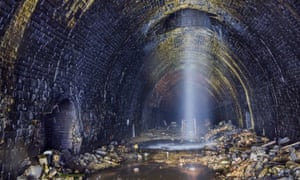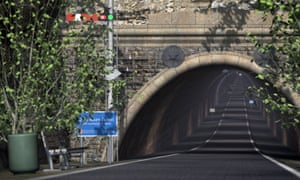
A campaign has accelerated to turn a disused railway line in Yorkshire into England’s longest cycle tunnel – instead of using £3m of public money to close it for ever.
The 1.4 mile (2.3km) Queensbury line, which runs 377ft (115 metres) below a hill between Halifax and Keighley in West Yorkshire, was closed in 1956 as rail travel declined and private car ownership increased.
The Department for Transport (DfT) wants to shut it permanently this year, filling in critical sections with concrete in a project campaigners say will cost about £3m – the same amount they claim it would cost to patch the tunnel and turn it into a subterranean cycling route.
The campaigners want the tunnel to be the centrepiece of a new cycle network connecting Halifax with Bradford, decreasing obesity, reducing pollution and easing traffic flows. Currently hardly anyone cycles in the area, put off by intimidating roads and brutal hills. The village of Queensbury, which gives the tunnel its name, is one of the highest parishes in England, sitting at 330 metres (1,100ft) above sea level.
Sustrans, the environmental charity, has produced a report suggesting the Queensbury cycle route could deliver £37.6m worth of economic, health and tourism benefits over 30 years.
A similar project in Bath proved popular when it opened in 2013. The mile-long Combe Down tunnel features an interactive light and sound installation and is now a tourist attraction in its own right.
The Monsal trail on the old Midland Railway line in the Derbyshire Peak District is now one of the national park’s most popular attractions. In 2016 more than 120,000 cycle movements were recorded by an automatic counter on the route, which opened in 2011 and runs for 8.5 miles between Blackwell Mill and Bakewell.
As things stand, Highways England’s Historical Railways Estate (HRE) – which acts as custodian of the disused railway tunnel on behalf of the DfT – could begin work to seal off the tunnel this June, according to Graeme Bickerdike, who coordinates the Queensbury Tunnel Society’s engineering activities.
A report commissioned by HRE in 2016 said it would cost £35m to upgrade the tunnel and five ventilation shafts to turn it into a bike route, leading the DfT to accelerate plans to shut it for good, Bickerdike said.
This would involve filling critical parts of it with concrete, making it all but impossible for the tunnel to ever be reopened, said Bickerdike, who writes about tunnels for a railway magazine.
However last year the Queensbury Tunnel Society commissioned specialist engineers who put together a plan to spend just £4.3m repairing the tunnel and laying an asphalt cycle path.
The society wants Bradford council to take ownership of the tunnel, with the £3m abandonment budget transferred as a dowry to cover future maintenance work.
A number of Bradford councillors support the plans but the council has yet to agree to take responsibility for the tunnel.
Bickerdike said constructing safe, pleasant, off-road cycle routes was the best way of getting people to cycle: “If we genuinely want to people to get out of their cars and on to bikes … the only thing that will encourage a lot of people to do that is to ensure there is infrastructure that means you are separated from lorries and buses and cars.”

No comments:
Post a Comment